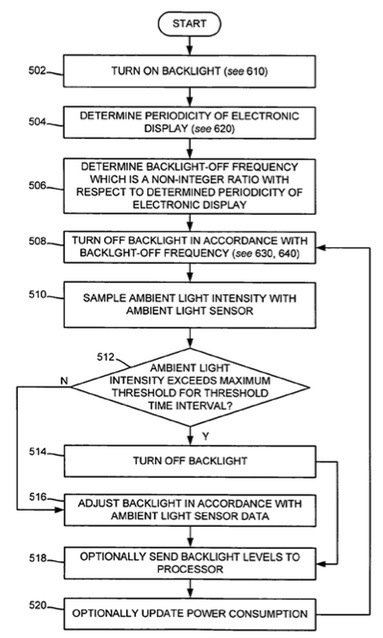An Apple patent (number 20120218239) for backlight control of an electronic device has appeared at the U.S. Patent & Trademark Office.
Embodiments are provided in the patent that may be utilized to eliminate stray light emissions from an LED while ambient light is being sensed. As such, dynamic backlight control systems for use with an electronic display are presented including: an ambient light sensor for sensing ambient light intensity; a backlight for illuminating the electronic display; a switch for controlling the backlight, the switch configured to set a backlight condition to ON or OFF in response to a backlight-off frequency such that the ambient light sensor senses the ambient light intensity in the absence of the backlight; a logic module for determining a backlight level in response to the ambient light intensity; and a backlight control circuit for adjusting the backlight to the backlight level in response to the ambient light intensity.
Here’s Apple’s background on the invention: “Portable electronic devices permeate everyday life in modem technological society. From portable information management systems to portable entertainment systems, the demand for new devices having more robust features and reliability continues to grow. One area that is critical to the success of an innovative electronic device is electronic display configuration and management. As may be appreciated, electronic displays utilized in portable electronic devices may be subject to a variety of environmental factors such as ambient light extremes, which may adversely affect a user’s viewing experience.
“For example, when an electronic device is carried from indoors to direct sunlight, the devices electronic display may be too dark to read until the display compensates for the ambient light change. Conversely, when an electronic device is carried from direct sunlight to indoors, the device’s electronic display may be too bright to view until the display compensates for the ambient light change.
“To address this problem, some electronic devices utilize an ambient light sensor in combination with an electronic display. The purpose of an ambient light sensor is to sense ambient light intensity. Sensed ambient light intensity generates data that may then be used to adjust electronic display brightness … As may be appreciated, backlight control may be utilized with an electronic display to adjust backlight levels (i.e. brightness) … As may be appreciated, a stepped increase in backlight level may provide at least some response to changing ambient light conditions. However, this technique represents a compromise. That is, the coarse granularity in backlight control often results in a backlight level that is too high or too low for a given ambient light condition. A finer granularity of backlight control may provide backlight levels that more closely match an ambient light condition and thus, may enhance a user’s viewing experience.
“n some conventional electronic devices, an ambient light sensor may be isolated from the devices electronic display in order to avoid stray light emissions from the display. However, in other electronic devices, an ambient light sensor may be co-located with the device’s electronic display in order to achieve, for example, a smaller form factor. In those examples, light emissions from the electronic display may interfere with the ambient light sensor.
“Thus, for example, ambient light intensity may be incorrectly read as too high because of contributing stray light emissions from the electronic display resulting in an inaccurate backlight level. As such, it may be advantageous to eliminate stray light emissions while an ambient light sensor is operating.”
The inventors are Wei Yao and Wei Chen.



